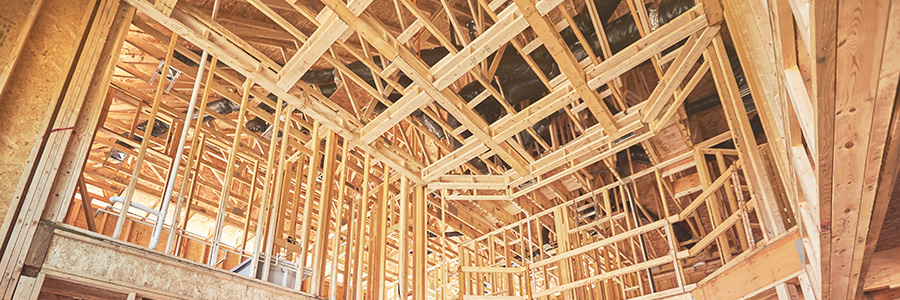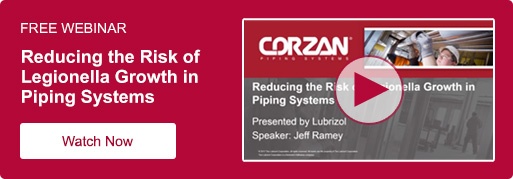Guidelines for Legionella Risk Management in Today's Plumbing Systems
Water-saving strategies such as lower-flow fixtures have become a vital tool in the conservation movement and in green buildings. But like many advances, even positive changes such as water-use reduction can have unintended consequences. There is rising evidence that lower flows may contribute to the formation of biofilm that provides opportunity for bacteria growth.
With water flow rates significantly lower than pre-conservation levels, water is staying in pipes longer. Longer residence times means opportunity for chlorine residuals to dissipate; without chlorine residuals, biofilm growth can occur, serving as a safe harbor for bacteria. Along with low flows, similar scenarios occur due to dead legs, stagnated water, and lower building water operating temperatures.
Biofilm and Legionella
Biofilm is a slimy glue-like substance that can harbor bacteria such as Legionella and E-coli. It forms on piping materials when biomass adhere to surfaces in wet conditions and provides the bacteria protection from high temperatures and chlorine-based disinfection methods.
These issues are in addition to other pipe-material factors that contribute to biofilm and bacteria growth, such as surface roughness, as well as characteristics that impact how a pipeline handles sanitization and temperature treatments once bacteria are detected.
One such bacterium is Legionella, which is most dangerous when aerated, such as through a showerhead or a fountain.
Legionella is a natural-occurring waterborne bacteria that multiplies in biofilm at various common temperatures of plumbing and cooling tower systems. The bacteria lead to Legionnaire’s Disease or “Legionellosis,” named after an outbreak of a new type of pneumonia at an American Legion convention in Philadelphia in 1976; 221 attendees contracted the disease, and 34 of them died. According to The Washington Post, “It was one of medicine’s greatest mysteries, devastating a group of convention-goers with shocking speed and leaving scientists scratching their heads about its cause.”
It is contracted by inhaling mist or vapor containing the bacteria, grows in the lungs and requires antibiotics. About 5,000 cases are reported each year, according to the Centers for Disease Control (CDC); reported cases are up 200% over the last 10 years. In general, it is not passed from person to person.
Legionella’s ideal growth range is 68 to 122 degrees F. The disinfection range for legionella eradication is 158 degrees F and higher.
Resources for Managing Legionellosis Risk
Investigations by the Centers for Disease Control show almost all outbreaks were caused by problems preventable with more effective water management.
The organization has a toolkit available: “Developing a Water Management Program to Reduce Legionella Growth and Spread in Buildings: A Practical Guide to Implementing Industry Standards.” The objective is to provide an interpretation of ANSI/ASHRAE Standard 188-2015. With a simple eight-question worksheet, the building owner and manager can determine if an entire building or parts of it are at increased risk for growing and spreading Legionella. The toolkit also includes the elements of a Legionella water management program, scenarios describing common water quality problems, and examples of how to respond to them to reduce the risk for Legionella and a section for healthcare facilities.
ANSI/ASHRAE Standard 188-2015 Legionellosis: Risk Management for Building Water Systems
The purpose of ANSI/ASHRAE Standard 188-2015 is to establish minimum Legionellosis risk management requirements for building water systems. Over 10 years in the making, this fact-based standard was approved by the ASHRAE Standards Committee, ASHRAE Board of Directors, and the American National Standards Institute in mid-2015. It is under constant maintenance by project and technical committees and is also accompanied by a guideline.
The standard provides minimum requirements for design including construction, commissioning, operation, maintenance, repair, replacement, and expansion of new and existing buildings concerning their associated potable and non-potable water systems and components. It is intended for use by owners and managers, as well as for those involved in design, construction, installation, commissioning, operation, maintenance, and service of centralized building water systems and components.
ANSI/ASHRAE 188-2015 applies to human-occupied commercial, institutional, multi-unit residential, and industrial buildings, excluding single-family residential buildings, as well as buildings containing cooling towers or evaporative condensers, whirlpool spas, ornamental fountains, misters, humidifiers, air washers, and other non-potable water systems or devices that release water droplets into the air. It also applies to projects meeting any of the following criteria: multiple housing units with one or more centralized potable hot water-heater systems, more than 10 stories, buildings designated primarily for occupants over age 65, healthcare facilities where a patient stays longer than 24 hours, or a building with one or more areas designated for housing or treating people at a high risk of contracting Legionnaire’s disease.
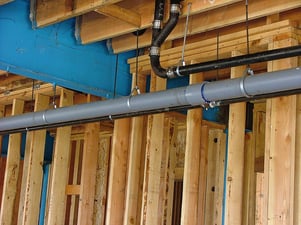
Of particular concern are electronic faucets, showerheads and hoses, aerators, faucet flow restrictors, ice machines, and water filters. Other areas include hot and cold water storage tanks, water heaters, expansion tanks, water-hammer arrestors, eyewash stations and emergency showers, and areas with infrequent use, stagnant water, and portions with tepid temperatures.
For designers, responsibilities under ANSI/ASHRAE 188-2015 comprise documentation and design compliance to address hazardous conditions, including diagrams for monitoring and control of the water system, water equipment, operating instructions and procedures, maintenance schedules, frequencies and procedures, no-flow and low-flow portions of piping and water systems and commissioning.
Designers must provide final installation documents, including monitoring points for confirming proper design temperatures, safety data sheets for materials used for building water system treatment, cleaning, flushing, disinfecting, etc. Finally, they must define detailed instructions for commissioning all systems, including procedures for flushing and disinfection.
Section 4.1.6 Recommended Treatment of ASHRAE Guideline 12-2000 Minimizing the Risk of Legionellosis Associated with Building Water Systems states:
- Maintain hot water storage above 140 degrees F where practical in healthcare facilities, nursing homes, and other high-risk situations
- Where decontamination is necessary, typically due to implication of and outbreak of Legionellosis, raise hot water to 170 degrees F and maintain while progressively flushing each outlet for minimum of 5 minutes
- Shock chlorination may be used, and would require chlorination of the water heater to 20-50 ppm for 2 to 24 hours
Pipe Material Considerations
Because biofilm is what provides a safe harbor for legionella growth, it’s also vital to be aware of design and material options that create biofilm friendly environments. A 1999 study “Biofilm Formation Potential of Pipe Materials in internal installations, KIWA 1999” found that biofilm growth was highest in copper and PEX; stainless steel, CPVC, and polypropylene experience less growth by as much as half. In the same study, the number of legionella in the test water came in above 150 cfu/ml for polypropylene and polybutylene, above 100 cfu/ml for PEX and stainless steel, but less than 25 cfu/ml for CPVC.
A reason for these results relates in part to the surface roughness of the materials. Simply, pipe materials with a smoother surface have less potential for biofilm growth. CPVC and PEX are two of the smoothest, with consistent surface roughness of 12.1 µm and 13.7 µm, respectively. Copper starts smooth at 7.9 µm but as it ages becomes rougher, to 2600 µm, dramatically increasing its biofilm growth potential.
Treatments recommended for disinfection also can have an impact on pipe material. Disinfection calls for high levels of chlorination and super-heated temperatures of 158 degrees or higher, which not all pipe materials are rated to withstand.
CPVC is naturally chlorine-, chloramine-, and chlorine dioxide-resistant because it is made with chlorine, which is a large atom that will protect the carbon chain it is bonded to. However, chloramines indirectly affect corrosion in copper pipes due to changing pH levels.
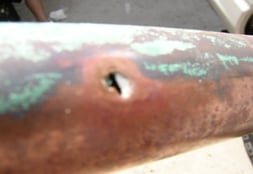 Chloramines can directly affect corrosion in copper pipes due to changing pH levels.
Chloramines can directly affect corrosion in copper pipes due to changing pH levels.
Polyolefins (polypropylene, PEX, and polybutylene) require antioxidants to protect against chlorine and disinfection byproducts like hypochlorous acid. Polypropylene manufacturers strictly recommend against use with chlorine dioxide; per ASTM F2023, PEX is not rated for service with chlorinated water above 140 degrees F.
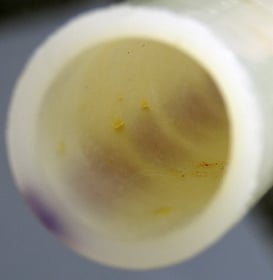 Chlorine degradation on PEX piping taken from a home in Battle Ground, Wash.
Chlorine degradation on PEX piping taken from a home in Battle Ground, Wash.
When designing plumbing systems, considerations of biofilm growth potential, disinfection treatments, temperatures, and piping materials all need to be considered.
As water conservation issues continue to take center stage, as they should, it’s vital to monitor how lower flows can contribute to biofilm formation and how that formation can be further exacerbated by design and material options. Using tools such as the CDC Toolkit and understanding ANSI/ASHRAE 188-2015 while employing its recommendations and requirements at both the design and use phases is essential to maintaining a safe water supply in all forms of human-occupied buildings.
Jeff Ramey is a piping systems consultant for Lubrizol.
This article originally appeared in March 2017 issue of Plumbing Engineer of TMB Publications, Inc. For more articles like this, visit www.plumbingengineer.com.
